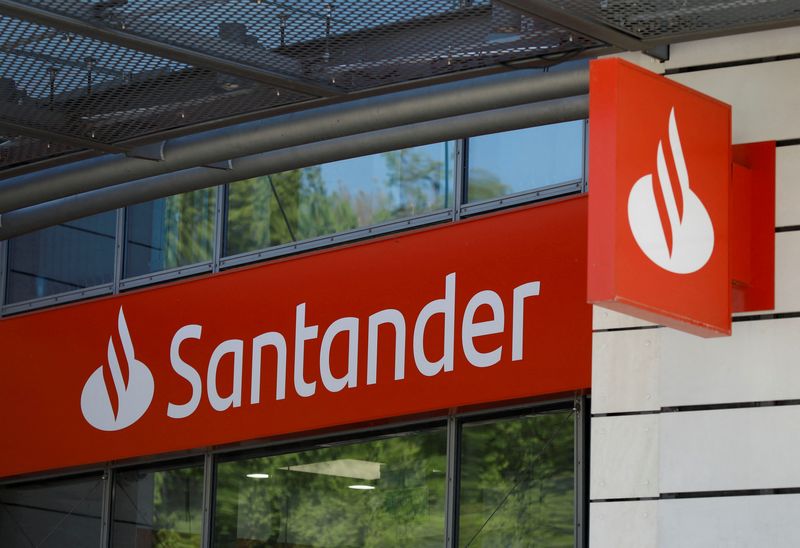By Jesús Aguado
MADRID (Reuters) -Santander reported a surge in first-quarter profit on Tuesday and reiterated financial targets for 2022, buoyed by higher revenues in Europe though higher costs and lending pressure in Brazil weighed on its shares.
Net profit at Spain's biggest bank jumped 58% in the quarter to 2.54 billion euros ($2.72 billion), beating a Reuters poll forecast of 2.26 billion euros.
Net profit also topped the 1.84 billion euros recorded in the first quarter of 2019, before COVID-19 hit Spain, although it was lower than the 2.78 billion euros booked in the fourth quarter of 2019.
For 2022, the bank maintained an underlying return-on-equity ratio target, a measure of profitability, of 13%, and a cost-to-income ratio of 45%.
Santander (BME:SAN) shares were down 6.1% at 1426 GMT, underperforming a 0.4% decline in the European banking index, as the bank's full year targets had been factored in.
Santander shares had risen 6% in the last 12 months.
JP Morgan welcomed a solid build-up in solvency in the quarter though Jefferies was more cautious given weaker lending income in Brazil, the bank's main market.
Inflationary effects, particularly in South America led to an increase of 8% in costs in constant euros at a group level.
Net interest income (NII) in Brazil, which accounts for around a quarter of the bank's overall underlying profits, rose 20.5% compared with the same quarter a year ago. But at constant euros, NII fell around 6% compared with the previous quarter.
Swiss broker UBS said Brazil "disappointed" in terms of NII on slowing volumes and falling margins, while costs there rose 14% year on year in constant euros.
Santander's net profit on an underlying basis rose overall by 19%, with Europe up 30% thanks to strong growth in lending income.
Efficiency measures implemented in Europe, coupled with ongoing interest rate hikes in Britain and Poland also buoyed quarterly earnings and helped to bring down the group's cost-to-income ratio down to 45%, from 47.9% in the previous quarter.
Santander's diversification, especially in Latin America, has helped the bank to cope with tough conditions for lenders in Europe since the financial crisis, where it has been cutting costs to cope with ultra-low interest rates.
Overall, net interest income, a measure of earnings on loans minus deposit costs, rose 11.3% to 8.86 billion euros in the first quarter, in line with forecasts.
In terms of solvency, Santander's tier-1 fully loaded capital ratio, the strictest measure of solvency, rose to 12.05% on a proforma-level from 11.96% in December, in line with its capital target of 12%.
The pro-forma capital ratio took into account the acquisition of a minority stake in its U.S. consumer unit and transactions, such as fixed-income broker Amherst Pierpont, which closed in April.

The bank also reiterated its policy to distribute 40% of underlying profit to shareholders, split evenly between cash dividend and share buybacks.
($1 = 0.8282 euros)